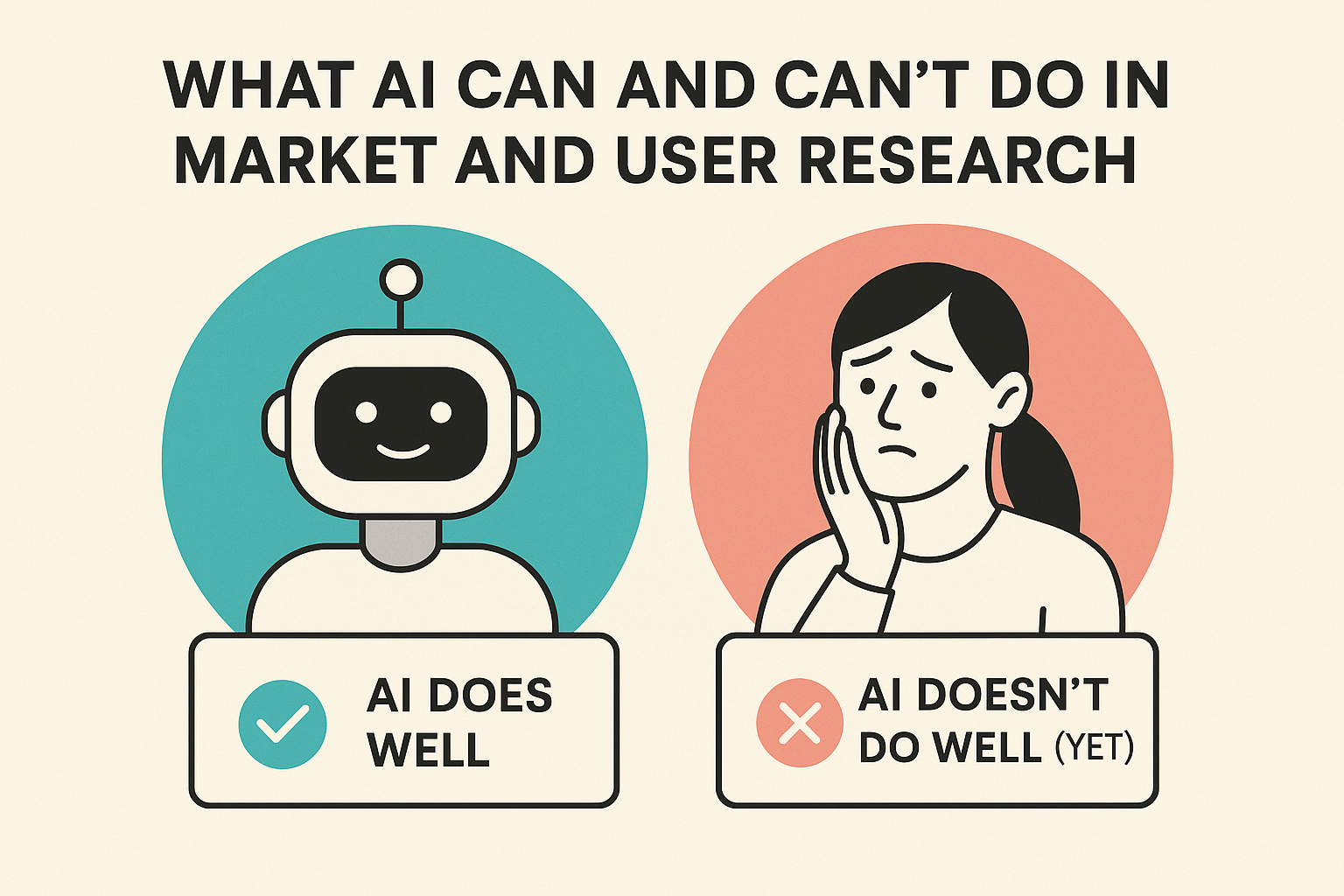
AI is rapidly transforming the way we run qualitative research. From instant transcription to AI-moderated interviews, it's never been easier to collect and process feedback at scale. But as powerful as these tools are, they’re not magic — and they’re not a substitute for critical thinking, human empathy, or strategic context.
If you’re a UX researcher, product manager, or insight lead, it’s essential to know where AI adds real value — and where it still needs a human in the loop. In this article, I’ll break down what AI currently does well in qualitative research, and what it doesn’t do well (yet). These insights are drawn from real-world experience using AI-powered tools like Usercall — a platform that uses AI to run user interviews and deliver thematic analysis in a fraction of the time.
AI can drastically speed up and scale the parts of research that are time-consuming or repetitive — without sacrificing quality. Here’s where it shines:
With AI-moderated interviews, you can run dozens (or even hundreds) of sessions in parallel — each with a consistent tone, script, and set of follow-ups. Tools like Usercall let you launch research with minimal setup, getting feedback from diverse users in hours, not weeks.
🔁 Example: I recently needed to test messaging across five user segments. With AI, I ran 40 interviews in 48 hours — something that would’ve taken my team weeks to schedule and moderate manually.
AI can cluster responses by themes, detect sentiment shifts, and surface repeated patterns far faster than human researchers. Instead of staring at sticky notes or transcripts for days, you get a first-pass synthesis almost instantly.
🧠 Usercall, for example, applies thematic clustering automatically — helping teams move from raw interviews to shareable insight decks in a single day.
Before talking to real users, you can run AI-powered synthetic interviews to validate early ideas, messaging, or questions. It’s a smart way to pressure-test assumptions, especially in discovery phases.
⚡ Think of it as a dress rehearsal for research — you catch confusing language or weak hypotheses before burning time with live participants.
AI takes care of the “ops” — scheduling interviews, sending reminders, managing consent, and organizing raw files. That’s time your team can spend on thinking, not admin.
📅 Bonus: AI-moderated interviews never cancel, show up late, or forget to hit record.
AI is surprisingly good at spotting changes in how users talk — even small word choices or emotional shifts — and surfacing these as signals that something matters.
🔍 For example, when multiple users say a feature is “frustrating” in different ways, AI may flag that cluster for review, even before your team catches it manually.
AI has come a long way — but it still struggles in areas that require context, empathy, or strategic thinking. Here’s where you should stay hands-on:
AI can automate basic screening, but it can’t truly vet whether someone is the right fit for your study — especially when you’re targeting niche roles, edge cases, or behavioral traits.
🎯 You still need human oversight in recruiting, especially for B2B or high-context user groups.
AI moderators are consistent — but not empathetic. They can’t build trust, read between the lines, or adapt to sensitive moments in real time.
💬 If your study touches on emotions, identity, or high-stakes decisions, a human interviewer is still essential.
Users often tell you what they think you want to hear — or rationalize decisions that don’t match their actual behavior. AI can’t yet catch those contradictions without observed context.
⚠️ This is where human researchers still outperform: detecting misalignment between words and reality.
AI lacks situational awareness. It can’t always tell why a feature matters in a specific setting (e.g., “It saves me time” might mean something different to a parent vs. a startup founder).
📌 Qual research is about nuance — and AI still needs human help to interpret it.
Some of the most powerful insights come from silence, hesitation, or the gaps in a conversation. AI isn’t good at recognizing what’s missing — only what’s there.
👀 Researchers must still look for what’s left unsaid — the unspoken pain points and emotional undercurrents that shape real user behavior.
The real power of AI in research isn’t replacement — it’s augmentation. The smartest teams are using AI to handle volume, speed, and pattern recognition — while researchers focus on strategy, storytelling, and decision-making.
Here’s how that might look:
AI is changing the way we do qualitative research — no question. But its role isn’t to replace human researchers. It’s to make us faster, sharper, and more focused on what matters.
Use it to scale the repetitive stuff, surface patterns, and accelerate delivery. But keep your head in the game for empathy, judgment, and strategy. That’s still your edge — and it’s not going away anytime soon.
Explore how Usercall can help you run AI-powered interviews, analyze detailed patterns with quotes automatically, and get to better insights faster — without sacrificing depth.